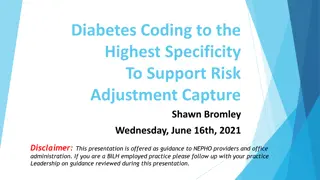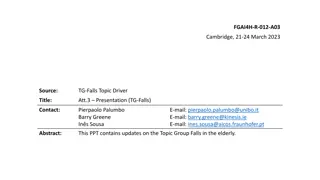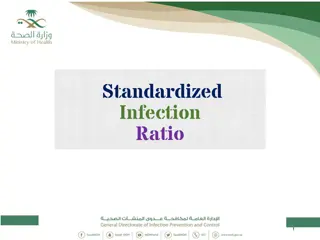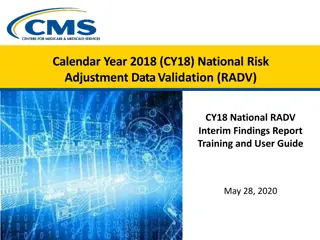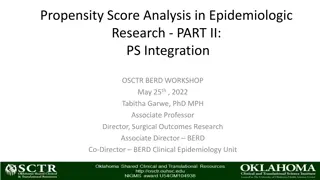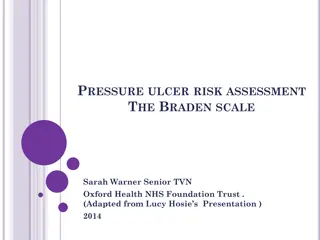Understanding Health Risk Adjustment Models in Healthcare
This content discusses the DHA Risk Adjustment Model, its clinical conditions, and the utilization of risk scores in various populations. It outlines how Health Affairs sponsored the development of a tailored risk adjustment model for the Prime Population and provides examples of clinical conditions such as circulatory/cardiovascular disorders and neoplasms/cancer. Additionally, it explores the implication for different population cohorts and models like the CMS Managed Care Risk Adjustment Model and the Wakely Model.
Download Presentation

Please find below an Image/Link to download the presentation.
The content on the website is provided AS IS for your information and personal use only. It may not be sold, licensed, or shared on other websites without obtaining consent from the author. Download presentation by click this link. If you encounter any issues during the download, it is possible that the publisher has removed the file from their server.
E N D
Presentation Transcript
Health Risk Data VERONIKA PAV KENNELL & ASSOCIATES
Objectives Describe the DHA Risk Adjustment Model Provide an overview of the Clinical Conditions and how they are used in the Risk Adjustment Model Highlight key fields Describe use and limitations of Risk Scores in different populations 2
Risk Adjustment Health Affairs sponsored the development of a MHS tailored concurrent risk adjustment model for the Prime Population Predicts the expected relative costliness of a beneficiary based on their diagnostic history. The higher a person s score is, the more resource intensive they are expected to be. For Risk Score calculation, also have a disease history file (health risk) Indications of up to 92 different clinical conditions a patient has been diagnosed with in the last 12 months. 3
Clinical Conditions - Examples Circulatory/Cardiovascular (H) High-Risk Neonate (H) Adjustment Disorders Circulatory/Cardiovascular (L) High-Risk Neonate (L) Affective Psychoses Circulatory/Cardiovascular (M) High-Risk Neonate (M) Anxiety-Related Disorders Circulatory/Cardiovascular (VH) Inflammatory Bowel Disease Asthma Congestive Heart Failure MulNeoplasm/Cancer (L) Bone/Joint/Muscle Infections/Necrosis Fracture/Dislocation (H) Neoplasm/Cancer (M) Central Nervous System (H) Fracture/Dislocation (L) Neoplasm/Cancer (VH) Central Nervous System (L) Fracture/Dislocation (M) Substance Abuse Cerebral Palsy, Hemorrhage Gastrointestinal/Infectious/Parasitic (H) Substance Dependence and Other Paralytic Syndromes Gastrointestinal/Infectious/Parasitic (L) Substance Induced Mental Disorders Cerebrovascular Disease Gastrointestinal/Infectious/Parasitic (M) Traumatic Brain Injury (H) Traumatic Brain Injury (L) 4
Clinical Conditions Cystic Fibrosis Use the DX to DX Category Excel Workbook to see what ICD 9 and ICD 10 Diagnoses map to each Clinical Condition 5
Model Development CMS Managed Care Risk Adjustment Model (HCC) Wakely Model DoD Model Chronic Illness & Disability Payment Model UCSD 6
This about the implication for different population cohorts Model Application FULL RISK MODEL DEMOGRAPHIC MODEL For beneficiaries enrolled less than 9 months without a life endpoint. Developed a demographic-only version of the model using age, gender, and beneficiary category. DoD adaptation of the Wakely model uses diagnosis data to estimate risk scores for each individual. Applies to beneficiaries enrolled for at least 9 months, plus those who die or are born during the year. 7
Model Structure Factors are additive each person s risk scores are summed across all relevant conditions. Constants: All beneficiaries have a 0.019 baseline score. Active Duty personnel receive an additional 0.233 points, covering readiness activities. Beneficiaries born during the year receive an additional 1.223 points. 92 health condition factors range from 0.094 (Traumatic Brain Injury Low) to 33.029 (High-Risk Neonate High) Additional rules for diagnosis mapping: Diagnoses from Active Duty health screenings are excluded To get credit for a risk category, an eligible diagnosis must appear on at least TWO different outpatient encounters OR a single outpatient encounter 8
Sample Risk Calculations Active Duty ACTIVE DUTY WITH PTSD AND BACK INJURY Active Duty with Ankle Sprain Risk Score = Risk Score = 0.019 (Intercept) 0.019 (Intercept) + 0.233 (AD Term) + 0.233 (AD Term) + 1.337 (Dorsopathy) + 0.219 (Fracture/Dislocation - Low) + 1.013 (PTSD) 0.471 2.602 9
Sample Risk Calculations - Dependents SPOUSE WITH PREGNANCY AND OTHER CONDITIONS Otherwise Healthy Child w/ Asthma Risk Score = Risk Score = 0.019 (Intercept) 0.019 (Intercept) + 0.402 (Diabetes) + 0.351 (Asthma) + 1.266 (Pregnancy Low) 0.370 + 0.122 (Endocrine Low) 1.809 10
Health Risk Data The Health Risk Data are divided into two files Health Risk File contains some demographic and enrollment information about the individual and the 92 clinical condition (Y/N) flags This file is the input into the Risk Adjustment Processor Each record represents a beneficiary. Risk Adjustment File also contains demographic and enrollment information as well as the risk scores. Each record represents a beneficiary. Demographic information includes: age, gender, marital status, etc. TRICARE/Enrollment Information: ACV Group/Enrollment Group, Enrollment MTF, Beneficiary Category, Sponsor Service, PCM ID, Residence Zip Code and Region, DoD Occupation Code, Medicare Eligibility 11
If a Retiree goes downtown and the appointment is covered by Medicare or OHI then the diagnoses on the claims may not visible to TRICARE. Health Risk File Key Fields Clinical Condition Flags (DXC1-DXC92) Y|N Flags for each condition If diagnoses occur in the direct care system (MTF) or purchased care system and at least part of the claim is paid by TRICARE What about DoD/VA Dual Eligibles who go to a VA Hospital for treatment? 12
Risk Adjustment File Key Fields Risk Source (RISK_SOURCE) C = Risk score calculated using clinical/diagnosis data D = Risk score calculated using demographic information only N = Risk score not calculated (for example, for non-Prime eligibles) Number of Months Eligible (NUM_MONTHS) Why are these important? Number of Months in Prime (NUM_PRIME) 13
Risk Adjustment File Key Fields Accrued Risk to Date Untruncated (RANGE_TRUNC_NO) Risk score based on diagnoses accumulated within the reporting period. (Unlimited risk) For enrollees with fewer than nine months of Prime enrollment, this score may not reflect the full measure of health risk, but provides an interim snapshot of emerging experience. Untruncated score indicates that there is no upper bound on the level of risk being measured. Under capitation for example, an upper bound (e.g, 100K or 250K) might be applied to mitigate a site s financial exposure to rare/high cost cases. 14
Risk Adjustment File Key Fields Prime Enrollee Risk Score - Untruncated (RISK_TRUNC_NO) Risk score based on diagnoses and drugs accumulated within the reporting period, unless fewer than 9 months of experience. (Unlimited risk) Reflects the relative risk level of an individual compared to the average Prime enrollee. For beneficiaries with fewer than 9 months of Prime enrollment within the reporting period, the score is based on demographics (age/gender/bencat) only. Untruncated score is appropriate for measuring relative risk in an environment where financial risk is unlimited. 15
Risk Adjustment File Key Fields High Cost User Flag (HIGH_COST_USER) A person is considered a high cost user if their weighted workload value is $100,000 or higher during the 12-month reporting period, during the current fiscal year, or during both. 16
Risk Scores FY 2018: Prime Active Duty Enrollment Group P P Ben Cat Common 4 4 Source of Risk Score C D Risk Score, No Truncation 922,658.96 276,228.14 1,198,887.10 FY Record Count Average Risk Score 2018 2018 Total: 1,023,845 328,276 1,352,121 0.90 0.84 0.89 Who are the D s in this care probably? 17
Risk Scores FY 2018: Retirees Ben Cat Common Age Group Code Risk Score, No Truncation Average Risk Score FY Record Count 2018 2018 2018 2018 2018 2 2 2 2 2 D (18-24) E (25-34) F (35-44) G (45-64) H (65+) 5,732 60,148 131,713 918,277 1,089,332 7,969.11 47,361.59 119,999.88 789,134.08 46,208.96 1.39 0.79 0.91 0.86 0.04 Do these Prime risk scores make sense TRICARE Retirees in these age groups? Low? High? 18
Risk Scores FY 2018: Retirees Depending on the Age Group, the number of Retirees who are Prime varies, but it s not more than ~50%. At the individual level for Prime Retirees, can look at the Number of Months Prime and their Source of Risk. 19
Risk Scores FY 2018: All Retirees Ben Cat Common 2 2 2 2 2 Age Group Code D (18-24) E (25-34) F (35-44) G (45-64) H (65+) Risk Score, No Truncation Average Risk Score FY Record Count 2018 2018 2018 2018 2018 5,732 60,148 131,713 918,277 1,089,332 7,969.11 47,361.59 119,999.88 789,134.08 46,208.96 1.39 0.79 0.91 0.86 0.04 FY 2018: Prime Retirees, Clinical Source of Risk 20
Risk Scores Risk Adjustment Model is meant to be used with the Prime population. For Non-Prime, or for new entrants can use Accrued Risk to Date, which can understate or overstate depending on what encounters are visible to TRICARE. 21
Uses of Risk Scores Have to think hard about your population and if the risk score is capturing all of the individuals care. There are many potential uses of risk scores: Identifying patients who are expected to be costly Balancing panels Adjusting for disease risk when comparing populations Additionally, the disease file could be helpful Disease management Case management Identifying cohorts with specified diseases 22
Questions vpav@kennellinc.com 23









